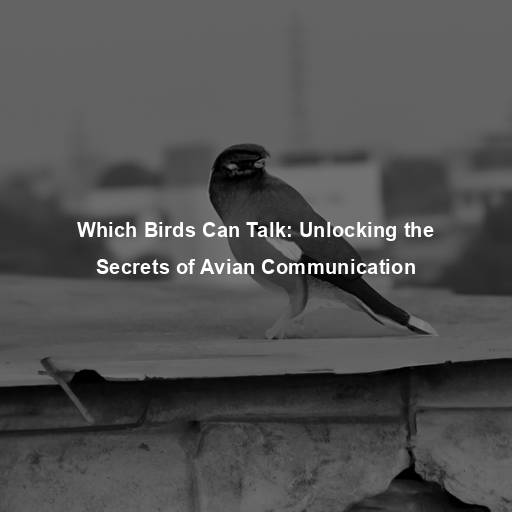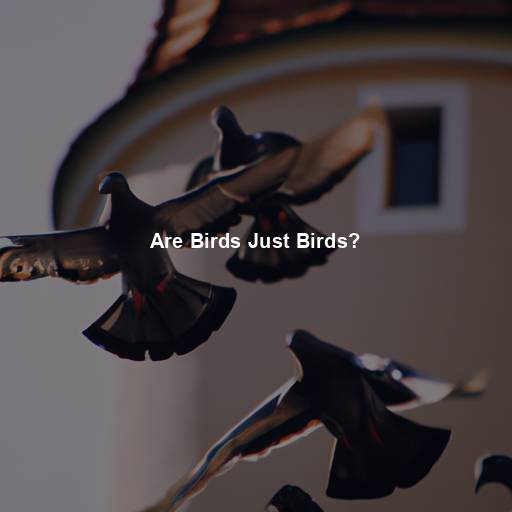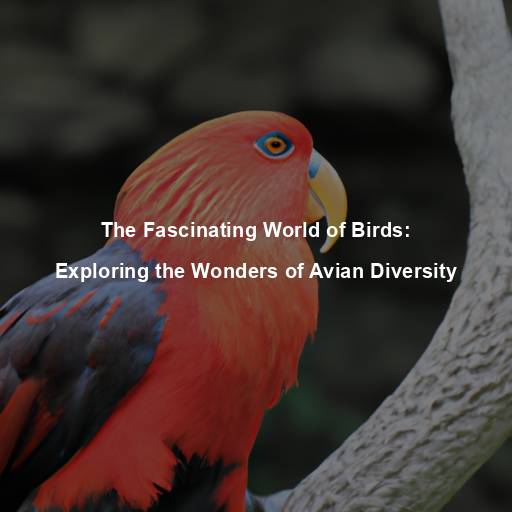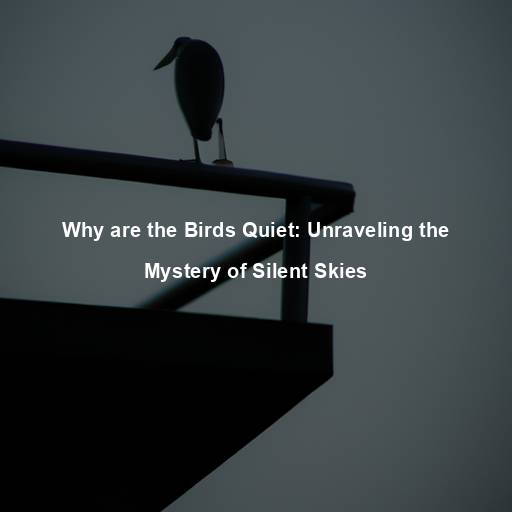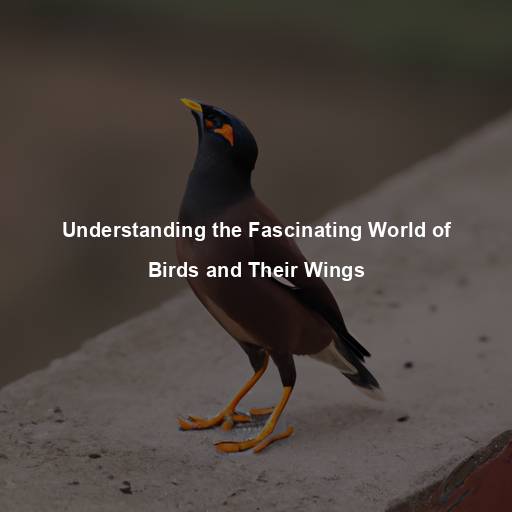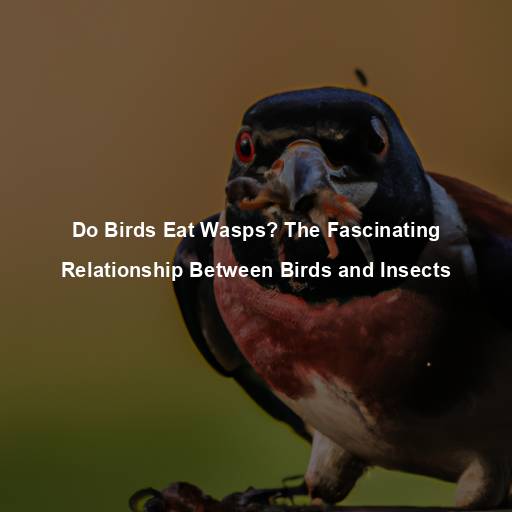Which Birds Can Talk: Unlocking the Secrets of Avian Communication
Last Updated on July 18, 2023 by Evan
Contents
- 1 Exploring the Fascinating World of Talking Birds
- 1.1 The Astonishing Art of Mimicry
- 1.2 Beyond Parrots: Other Birds That Talk
- 1.3 Unlocking the Secrets of Avian Communication
- 1.4 Talking Birds as Pets: A Word of Caution
- 1.5 A Symphony of Chatter and Melody
- 1.6 Vocal Anatomy: The Syrinx and Beyond
- 1.7 The Role of Social Interaction
- 1.8 The Cognitive Puzzle: Unlocking the Secrets of Talking Birds
- 1.9 The Ethics of Keeping Talking Birds
- 2 Unlocking the Melodies of the Avian World
- 3 FAQs: Which Birds Can Talk
Exploring the Fascinating World of Talking Birds
Throughout history, birds have mesmerized us with their dazzling colors, fluid movements, and captivating melodies. Yet, who could have anticipated that some of these winged marvels possess the extraordinary talent to imitate our very own human voices? The realm of talking birds has long been a source of bewilderment for researchers, avian aficionados, and those who share their homes with these chatty companions. This article embarks on a journey into the captivating realm of avian communication, unveiling the enigmatic identities of our feathered linguists and unraveling the mysteries that underlie their astounding linguistic prowess.
The Astonishing Art of Mimicry
It’s no secret that parrots have a knack for mimicry, captivating us with their ability to replicate sounds and vocalizations. But did you know that this talent is not just limited to parrots? Other bird species have also been caught in the act of imitating, adding a touch of perplexity to the avian world. While it’s true that parrots, especially those belonging to the Psittacidae family, have an edge with their specialized vocal structure known as the syrinx, it’s their remarkable cognitive prowess that truly sets them apart.
Parrots: The Masters of Verbal Replication
Parrots, renowned for their exceptional mimicry skills, have garnered the most attention among talking bird enthusiasts. Species like the African Grey Parrot, the Eclectus Parrot, and the Yellow-naped Amazon Parrot are hailed as masters of verbal replication, capable of mimicking human speech patterns, intonations, and even emotions.
African Grey Parrot: Einstein of the Avian World
Step into the enchanting world of the African Grey Parrot, a feathered marvel that continually leaves experts and enthusiasts alike in awe. These extraordinary avian creatures, often hailed as the geniuses of their kind, possess a mesmerizing talent for communicating with humans through speech mimicry. With a penchant for picking up words faster than you can say “Eureka,” African Grey Parrots effortlessly build an astonishing lexicon of diverse phrases and expressions. Yet their linguistic prowess doesn’t end there – these feathered linguists astound audiences by not just echoing our voices, but cleverly using their acquired vocabulary to meaningfully interact with us.
Eclectus Parrot: The Colorful Chatterbox
Known for their stunning plumage and playful personalities, Eclectus Parrots are another popular choice among talking bird enthusiasts. These vibrant parrots possess a melodious voice and can mimic human speech with surprising clarity. With proper training and socialization, Eclectus Parrots can develop an extensive vocabulary and even engage in short conversations with their human companions.
Yellow-naped Amazon Parrot: A Voice to Remember
Get ready to be blown away by the mesmerizing talents of the Yellow-naped Amazon Parrot! Hailing from the vibrant landscapes of Central America, these feathered wonders are causing quite a stir in the avian world with their captivating speaking skills and unique vocal range. From mimicking the dulcet tones of human speech to effortlessly replicating the sounds of their natural surroundings, these charismatic creatures have become the talk of the town, or should we say, the bird sanctuary. Breaking the mold of traditional pets, bird enthusiasts are flocking to the Yellow-naped Amazon Parrot’s side, eager to experience their astonishing ability to flawlessly mimic everything from ambient noises to melodic musical tunes.
Beyond Parrots: Other Birds That Talk
While parrots steal the spotlight when it comes to talking birds, there are other avian species with surprising vocal talents. Let’s explore some of these lesser-known yet equally fascinating birds.
Hill Myna: The Songbird of Asia
The Hill Myna, native to Southeast Asia, is celebrated for its melodious and articulate vocalizations. These birds possess a remarkable ability to mimic human speech, often with astonishing clarity and accuracy. Due to their captivating vocal talents, Hill Mynas have become highly sought after as pets and are revered in various cultures for their unique ability to replicate human language.
Common Starling: A Mimicking Maestro
The exquisite Common Starling, residing in Europe and certain parts of Asia, reveals a remarkable flair for both melody and deceit. Aptly named, these avian artists possess a gift for imitating an astonishing medley of sounds, from the dulcet tones of human speech to the fierce calls of fellow animals, even venturing into the realm of mechanical clamor. Their prodigious vocal collection is a labyrinth of wonders, a mysterious tapestry that piques the curiosity of those who delve into the intricacies of avian linguistics.
Lyrebird: Nature’s Audio Copycat
The Lyrebird, a fascinating species found in the vast lands of Australia, is an absolute master of mimicry. With an unparalleled ability to replicate an array of sounds, this avian virtuoso can effortlessly imitate the calls of various bird species, the crisp click of a camera, or the distinctive buzz of a chainsaw. While their repertoire mainly consists of echoing the sounds of their natural habitat and fellow feathered friends, it is not uncommon for these captivating creatures to dabble in imitating human speech, albeit not as frequently as their parrot or myna counterparts. Prepare to be astounded by the Lyrebird’s captivating symphony of mimicry!
Unlocking the Secrets of Avian Communication
The captivating skill possessed by certain bird species to mimic human speech leaves us astounded, provoking a flurry of questions about the intricate realm of avian communication and the enigmatic forces driving this extraordinary phenomenon. Despite substantial strides made by scientists in deciphering the secrets of avian vocalizations, there persists an air of uncertainty, with numerous aspects eluding our understanding, shrouded in a cloak of mystery.
The Role of Vocal Learning
Vocal learning, the ability to acquire and modify sounds through imitation, is considered a crucial factor in a bird’s ability to talk. Parrots, mynas, and certain songbirds are among the few avian species known to possess this unique skill. By studying these vocal learners, scientists hope to gain insights into the neural and genetic mechanisms that enable birds to mimic human speech.
Cognitive Abilities of Talking Birds
Talking birds possess a remarkable linguistic aptitude that transcends mere mimicry. These feathered prodigies have the ability to connect words with their corresponding meanings, grasp rudimentary grammar structures, and conquer puzzles with ease. Experts in the field posit that the extraordinary cognitive skills demonstrated by talking birds hold the potential to shed light on the evolutionary progression of language and intellect.
The Influence of Socialization and Training
While certain bird species possess a natural inclination for mimicry, proper socialization and training play a pivotal role in honing their linguistic skills. Positive reinforcement, patient guidance, and interactive engagement are essential for unlocking the full potential of a talking bird. With the right environment and nurturing, these feathered friends can develop an impressive repertoire of vocalizations and become cherished companions.
Talking Birds as Pets: A Word of Caution
There’s a certain mystique surrounding the idea of having a talking bird as a companion. The enchanting notion of a feathery friend engaging in clever banter and imitating our own voices is truly captivating. Yet, those considering the feathered journey should approach the idea with a healthy dose of thoughtfulness and reasonable outlooks. After all, the world of avian companionship is filled with both surprises and uncertainties.
Lifelong Commitment and Care
Talking birds, like all pets, require dedicated care, attention, and a lifelong commitment. These intelligent creatures thrive in environments that provide mental stimulation, social interaction, and ample opportunities for physical exercise. Before bringing a talking bird into your life, ensure that you can provide the necessary time, resources, and love required to meet their complex needs.
Ethical Considerations
The heartbreaking impact of the rampant plucking of vibrant parrots from their habitats to satisfy the insatiable demand of the pet trade cannot be underestimated. However, there is a glimmer of hope amidst this bewildering chaos. By embracing an ethical mindset and endorsing responsible breeders or choosing to adopt these majestic birds from reputable avian rescue organizations, we have the power to ignite a spark of conservation and safeguard the precarious existence of these extraordinary creatures and their precious ecosystems.
A Symphony of Chatter and Melody
In the enchanting realm of avian communication, talking birds stand out as extraordinary performers. Their ability to mimic human speech not only astounds and entertains but also offers a glimpse into the fascinating world of avian intelligence and the evolution of language. Whether as pets or subjects of scientific inquiry, these feathered linguists continue to captivate our hearts and inspire wonder, reminding us of the profound connections that exist between humans and the animal kingdom. So, the next time you find yourself in the presence of a talking bird, listen closely, for within their melodious chatter lies a symphony of avian eloquence waiting to be discovered.
There is an undeniable allure to the enchanting melodies of birdsong, but what if I told you that some avian creatures possess the perplexing ability to actually mimic human speech? It may seem like something out of a fairy tale, but science has unraveled the secrets behind this mesmerizing behavior. Join us as we embark on a captivating journey into the intricate world of avian communication, exploring the intricate mechanisms that grant certain bird species the astonishing talent of talking like us humans.
Vocal Anatomy: The Syrinx and Beyond
At the heart of a bird’s vocal prowess lies its unique vocal anatomy. While parrots are often hailed as the champions of mimicry, other bird species possess their own adaptations for vocalization. The syrinx, a specialized vocal organ located at the base of a bird’s trachea, is responsible for producing the diverse range of sounds emitted by avian vocal learners.
Syrinx: Nature’s Vocal Synthesizer
Have you ever wondered how birds achieve those melodic and mesmerizing tunes? It’s all thanks to the wondrous and enigmatic syrinx. This intricate masterpiece of muscles, membranes, and cartilage grants our feathered friends the power to orchestrate the very essence of sound. From controlling pitch to modulating volume and even shaping timbre, the syrinx is the ultimate tool behind their extraordinary chatter.
Neural Pathways and Learning
The fascinating world of sound replication unveils a captivating dance between the syrinx, the brain, and the intricacies of the nervous system. Birds with the unique skill of vocal mimicry, like parrots, possess neural pathways designed to master the art of imitating sounds. Through these pathways, these feathered virtuosos can not only perceive and process vocalizations but also reproduce them, enchanting us with their wondrous ability to mimic human speech.
The Role of Social Interaction
The intricate mechanisms of a bird’s body allow it to mirror a myriad of sounds, but the fascinating journey to vocal proficiency extends beyond mere physiology. The intricate tapestry of social interactions weaves together to mold their linguistic prowess. Remarkably akin to our own infants, these avian prodigies grasp the art of communication through vigilant observation, relentless practice, and, most importantly, the invaluable input from their devoted caregivers or companions.
Imitation and Social Bonding
For birds, mimicking sounds is not solely about communication but also about establishing and strengthening social bonds. In the wild, young birds learn vocalizations from their parents or flock members, imitating their calls and songs to fit into the social fabric of their community. Similarly, pet birds acquire their vocal repertoire through interaction with their human companions.
The Cognitive Puzzle: Unlocking the Secrets of Talking Birds
The ability of certain bird species to mimic human speech raises intriguing questions about avian cognition and the evolution of language. Scientists have been studying talking birds to gain insights into the underlying cognitive processes and mechanisms that enable these creatures to acquire, comprehend, and produce human-like vocalizations.
Memory and Vocal Repertoire
When it comes to talking birds, prepare to be captivated by their mind-boggling knack for remembering and reproducing an astonishing array of sounds. It’s not just about copying and pasting though, these feathered wonders possess the uncanny ability to grasp the context and usage of their vocal expressions. Exploring the intricate neural underpinnings of this memory prowess could unlock valuable insights into the mysteries of memory as a whole. Get ready to dive into the bewildering world of avian memory!
Syntax and Comprehension
While birds may not possess the same linguistic complexity as humans, they do exhibit a basic understanding of syntax. Studies have shown that some talking birds can arrange words in a meaningful sequence and respond appropriately to specific cues or commands. Unraveling the cognitive processes behind this syntactic comprehension could offer valuable insights into the evolution of language and the cognitive abilities of non-human animals.
Problem-Solving and Intelligence
When it comes to the world of feathered friends, talking birds truly defy expectations. These avian wonder-workers possess an uncanny knack for cracking puzzles and adapting to new situations, using their brains in ways that leave us utterly perplexed. From mimicking our words to unraveling cause-and-effect conundrums, these eloquent aviators are unlocking the secrets of avian intelligence while offering tantalizing insights into the intricacies of human cognition. So, get ready to be awestruck as we delve into the fascinating minds of our winged companions and uncover the surprising parallels between their cognitive abilities and our own.
The Ethics of Keeping Talking Birds
Owning a talking bird may seem intriguing and enchanting, but it is imperative to delve into the ethical considerations surrounding the keeping of these remarkably intelligent creatures as companions. The decision to become a responsible bird owner entails acknowledging the intricate demands they have in terms of their physical, social, and emotional well-being. It’s not just about having a chatty sidekick; it’s about understanding and honoring the complexities of our avian friends.
Enriched Environment: A Key to Well-Being
Talking birds thrive in environments that provide mental stimulation, social interaction, and opportunities for physical exercise. A spacious cage, plenty of toys, and regular out-of-cage time are vital for their well-being. Additionally, providing a varied and nutritious diet, as well as regular veterinary care, is essential for their overall health.
Socialization and Interaction
Birds that possess the ability to converse are inherently social beings, and as such, they seek frequent interaction with those who share their living space. In order to flourish, these avian marvels crave positive feedback, stimulating dialogue, and interactive recreational activities. Should their sociability be disregarded, the aftermath may entail a wearisome existence, feelings of seclusion, and the manifestation of unwanted behavioral patterns.
Conservation and Responsible Pet Ownership
The capture and trade of wild parrots for the pet industry have had devastating consequences on many parrot species and their natural habitats. To promote conservation efforts and support responsible pet ownership, potential bird owners should consider adopting from reputable avian rescue organizations or obtaining birds from ethical breeders who prioritize the well-being and conservation of these remarkable creatures.
Unlocking the Melodies of the Avian World
As we continue to unravel the mysteries of avian communication, the world of talking birds remains a captivating subject of scientific inquiry and a source of endless fascination. The ability of certain bird species to mimic human speech serves as a testament to the incredible diversity and complexity of the natural world.
Intrigued by the complexities of vocal learners and their mysterious cognitive powers, researchers dive headfirst into unraveling the enigmatic evolution of language. Through their relentless pursuit of knowledge, they aim to unearth the secrets buried deep within the neural mechanisms that govern the production of our speech. But as their studies reach new heights, a fascinating truth emerges: our avian companions, with their mesmerizing ability to converse, unveil a world brimming with intelligence and brilliance. By simply acknowledging and embracing these impressive talents of our feathered friends, we embark on a riveting journey to reconnect with nature and bask in the marvels of avian communication.
When encountering a conversing avian creature, let us pause and appreciate the awe-inspiring abilities of these feathered linguists and the deep connection they form with their human counterparts. Through their enchanting songs, they unveil a bridge between our diverse species, serving as a poignant reminder of the intricate interdependence that permeates the fabric of life on our beloved planet Earth.
FAQs: Which Birds Can Talk
What does it mean when we say birds can talk?
When we say birds can talk, we are referring to their ability to mimic sounds and reproduce them vocally. This does not mean they possess language or have the same level of understanding and communication as humans, but rather that some bird species have the ability to imitate certain sounds, including human speech.
Can all birds talk?
Contrary to popular belief, not all feathered creatures possess the enchanting ability to mimic human speech. This captivating talent, reminiscent of a lost art form, remains relatively rare among the diverse avian species. However, there exists an exclusive league of feathered beings, including the charismatic parrots, flamboyant cockatoos, and select songbird species, who possess the perplexing gift of replicating and articulating our complex linguistic melodies.
Which species of parrots can talk?
When it comes to the art of communication, there are some feathered friends who excel in the unexpected realm of talking. Take the African grey parrots, Amazon parrots, and the delightful budgerigars, also known as budgies or parakeets – they have truly mastered the perplexing talent of mimicry, effortlessly imitating human speech like seasoned professionals. These parrot species have burst onto the scene, showcasing their uncanny ability to engage in the most unexpected conversation with their human companions.
How do birds learn to talk?
Birds that can talk learn to do so through a process of vocal imitation. They listen to sounds in their environment, including human speech, and then try to reproduce those sounds using their vocal apparatus. This learning process involves trial and error, practicing and refining their vocalizations over time.
Can birds understand the meaning of the words they say?
Birds, with their astonishing talent for impersonating human speech, have long mesmerized us. However, as captivating as their mimicry may be, a veil of uncertainty surrounds their understanding of the words they utter. It is a tantalizing enigma, where imitation and comprehension diverge, revealing the intricate complexity of language acquisition and the boundaries of avian communication.
Can I teach my bird to talk?
Yes, it is possible to teach certain birds to mimic human speech. By consistently exposing them to specific words or phrases, speaking clearly and repetitively, some birds can learn to imitate these sounds. It requires patience, consistency, and a positive reinforcement-based training approach.
Are there any other animals besides birds that can talk?
While birds are the most well-known talking animals, there are a few other non-avian species with limited talking abilities. Some species of dolphins, seals, and beluga whales have been known to mimic human words and sounds to a certain extent. However, the ability to talk, in the full sense of linguistic communication, remains unique to humans.

